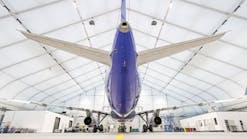Flint Bishop Airport Deploys Mobile Smart Helmet Technology to Detect Elevated Temperatures
Flint Bishop Airport announces that it is not only the first airport, but the first business in the nation to deploy the Smart Helmet, linked with the IoT platform Metamorphosis, in a cutting-edge partnership with its manufacturer, KeyBiz,in Rome, Italy.
“This device is a game-changer,”stated Airport Director Nino Sapone.“It has the ability to perform several functions, including detecting the temperature of multiple people at a distance of up to 21 feet with precision accuracy The helmet is the first mobile platform of its kind, allowing our Police Officers the flexibility to walk the terminal building and randomly screen both incoming and outgoing passengers.We couldn’t be more pleased to be partnering with Key Biz to spearhead the incorporation of this advanced technology in the United States.”
“Flint Bishop International Airport Police will stand alone as the first group in the country to utilize this new technology,” said Steve Lorincz, TSA’s Federal Security Director Detroit Field Office. “The airport, along with TSA’s initiatives from our “Stay Healthy. Stay Secure.”Campaign,utilizing acrylic barriers and Credential Authentication Technology (CAT) units to minimize personal touch points, remain committed to the health and safety of our front line workers and airline travelers to help minimize the spread of COVID-19.”
The Smart Helmet’s IoT solution integrates an Artificial Intelligence module for processing thermal images, Augmented Reality displays, communication sensors and advanced aerospace technology. The airport will initially be using it as an additional layer of protection for our passengers against COVID-19, but the helmet has numerous additional capabilities. Some of which we will utilize immediately, and others that we will incorporate moving forward.
In addition to the temperature detection capabilities,our Police Officers will also have the immediate ability to use the following features:
- Face recognition: Photographs can be uploaded to the helmet itself, allowing the officers to facially scan individuals in the airport and detect matches. This feature will be especially beneficial in the detection of wanted criminals, suspects,missing persons and the like.
- License plate recognition
- QR Code Detection
The device also has the ability to be upgraded with additional features, should the airport decide to add more services to the technology.
The Smart Helmet has already been deployed in a few airports in other parts of the world. An example would be the Rome Airport. It has been a remarkable success and asset to the organization.Please follow the link to see how the technology works, as well as how the visual read-out appears to the officer.
Once an elevated temperature, above 100.4 degrees Fahrenheit,has been detected the officer will approach the passenger and accompany them to the ticket counter of the airline they are/ were flying, advising an agent or manager of their finding. The officer will wait to hear the airline’s determination on whether the passenger will fly or be denied boarding, and ensure that their decision is followed.
If the individual with an elevated temperature is not a passenger, they will be asked to leave the terminal building in the name of health and safety. The officer will also ask for their name and attempt to identify whether or not they came in contact with anybody else while in the terminal. In both instances, the information gathered will be recorded for any potential contact tracing and forwarded to the proper authority if it is determined that there was a positive test result.
This procedure is key in assisting us in the identification of potentially infected individuals, and is far preferable to missing the opportunity. Additionally, any resulting contact tracing would serve as a means to identify others who were in close proximity to the infected individual, create a ring around them that can be sealed off, preventing the next level of spread.




